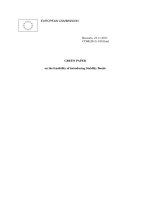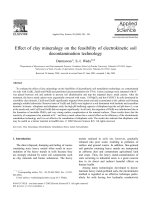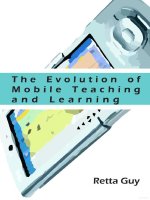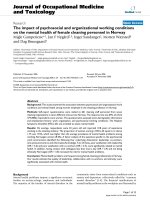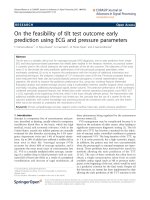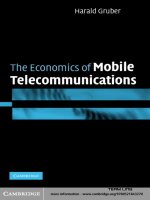The feasibility of mobile telework virtual working
Bạn đang xem bản rút gọn của tài liệu. Xem và tải ngay bản đầy đủ của tài liệu tại đây (2.61 MB, 129 trang )
The Feasibility of Mobile Telework/Virtual Working
“The Feasibility of Mobile Telework / Virtual
Working: A Study of 3PL firms in India”
NAME
:
CLARISSA JAYASHREE FRANCIS
NUMBER
:
1765212
COURSE
:
INSTITUTION :
DATE
:
MBA IN PROJECT MANAGEMENT
DUBLIN BUSINESS SCHOOL
16th AUGUST , 2013,
WORD COUNT : 18015
Dissertation submitted in partial fulfilment of the requirement for the degree of Masters Business
Administration in Project Management August, 2013 at Liverpool John Moore’s University in
conjunction with Dublin Business School
Page 1
The Feasibility of Mobile Telework/Virtual Working
TABLE OF CONTENTS
Contents
Declaration.................................................................................................................... 4
List of Tables/Illustration ............................................................................................ 5
Acknowledgements ...................................................................................................... 7
Abstract ......................................................................................................................... 8
1.1 Background of the Problem or Definition of the Problem............................................. 11
1.2 Need for study, research aim & objectives and the hypothesis to be tested ............... 15
1.3 Approaches to the dissertation...................................................................................... 17
1.4 The organisation of the research ................................................................................... 18
1.5 The scope and limitations of the research..................................................................... 19
1.6 Major contributions of the study ................................................................................... 20
2.1 The Virtual Office / Working.............................................................................. 22
2.1.1 Mobile telework / virtual working .............................................................................. 22
2.1.2 Key models of virtual office setup .............................................................................. 26
2.1.3 Virtual office implementation and Impact.................................................................. 28
2.2 3pl India and Virtual Working ........................................................................... 32
2.2.1 3pl operations in India ................................................................................................ 33
2.2.2 Key functions that can be virtualised.......................................................................... 36
2.3 Workforce ............................................................................................................. 38
2.3.1 Multigenerational workforce ...................................................................................... 38
2.3.2 Work/life balance........................................................................................................ 41
2.4 Virtual Team ........................................................................................................ 42
2.4.1 Formation of a virtual team and Challenges to overcome ......................................... 42
2.4.2 Key Factors of managing a virtual team and the challenges ...................................... 43
3.1 Research Methodology .................................................................................................. 48
3.1.1 Research Philosophy–Epistemology-Positivism/Ontology-Objectivism ................. 49
3.1.2 Research Approach – Deductive ............................................................................. 51
3.1.3 Research Strategy – Survey (online / email) ........................................................... 52
3.1.4 Research Choice - Mono Method - Quantitative Research .................................... 53
3.1.5 Time Horizon – Cross-sectional ............................................................................... 53
Page 2
The Feasibility of Mobile Telework/Virtual Working
3.2 Proposed Sampling Method – Non-probability – Snowball........................................... 53
3.3 Data Collection .............................................................................................................. 54
3.4 Practical Efforts .............................................................................................................. 56
3.5 Limitation ....................................................................................................................... 56
3.6 Ethics ............................................................................................................................. 57
3.8 Personal bias .................................................................................................................. 58
4.0 Data Analysis/Findings ........................................................................................ 58
4.1 Questionnaire findings ................................................................................................... 59
5.1 Limitation of the research .............................................................................................. 98
7.1 Self-assessment and Learning from the course ........................................................... 106
8.0 Bibliography ....................................................................................................... 110
Cover Letter for Questionnaire .......................................................................................... 122
Questionnaire .................................................................................................................... 123
SPSS – data coding screenshot........................................................................................... 128
Netq-Survey Screen Shot ................................................................................................... 129
Time Allocation .................................................................................................................. 129
Page 3
The Feasibility of Mobile Telework/Virtual Working
Declaration
I hereby declare, the dissertation entitled “The Feasibility of Mobile Telework /
Virtual Office: A Study of 3PL firms in India” is submitted in partial fulfilment of the
requirements for the award of the degree of Master of Business Administration in Project
Management, is a record of original work undertaken by self under the supervision and
guidance of Lecturer Clive Gargan, Dublin Business School (LJMU), Dublin, Ireland. All
assistance self has received to complete this research paper has been duly acknowledged. In
addition, I certify that all sources of information and literature utilised has been duly
indicated in this thesis. This project work has not formed the basis for the award of any
Degree/ Diploma/ Associate ship/ Fellowship of similar titles to any candidate of any
university.
Place: Dublin
Date: 16/08/2013
.................................
Signature of the Student
Page 4
The Feasibility of Mobile Telework/Virtual Working
List of Tables/Illustration
2.1.3: Table 1 – Beneficial Impacts of Virtual Working
2.2.1: Table 2 Research Philosophy
3.1.2:Table 3 Research approach
2.0: Figure 1 Literature Review model
2.2.3: Figure 2 Main components of 3pl
2.3.1: Figure 3 the general characteristics of three generations of employees.
2.3.1: Figure 4 Generational Attributes
2.4.1: Figure 5 Macroergonomic Work System Design Perspective of Telecommuting
2.4.2: Figure 6 Virtual workplace challenges
3.2: Figure 7 Research Methodology
4.1: Figure 8 Organisation current location
4.1: Figure 9 Total number of employees
4.1: Figure 10 Office Department
4. 1: Figure 11 Highest level of education
4. 1: Figure 12 Mode of commuting
4. 1: Figure 13 Percentage of salary being spent on commuting
4. 1: Figure 14 Distance in kms from home to work
4. 1: Figure 15 Time taken to travel to work (in minutes)
4.1: Figure 16 Time taken to return home from work (in minutes)
4. 1: Figure 17 Arrival at work place
4. 1: Figure 18 Departure from work place
Page 5
The Feasibility of Mobile Telework/Virtual Working
4. 1: Figure 19 Awareness of meaning of virtual working
4. 1: Figure 20 Virtual working “growing phenomenon” in India
4. 1: Figure 21 Acceptance of virtual working if made available
4. 1: Figure 22 Office Department * Acceptance of virtual working if made available Cross
tabulation.
4. 1: Figure 23 Gender
4. 1: Figure 24 No of children
4. 1: Figure 25 Family type
4. 1: Figure 26 No of family members at home
4. 1: Figure 27 Cross Tabulation with family type , Chi-Square tests and Bar chart
4. 1: Figure 28 Age (years)
4. 1: Figure 29 Bar chart * Acceptance of virtual working if made available Cross tabulation.
4. 1: Figure 30 Job Title
4. 1: Figure 31 Perceived Benefits - Employees
4. 1: Figure 32 Cross tabulation Job title and Perceived Benefits of employees
4. 1: Figure 33 Perceived Benefits - Employers
4. 1: Figure 34 Acceptance of virtual working if made available Cross tabulation with
perceived benefits - employers.
7.0: Kolb’s learning styles
Page 6
The Feasibility of Mobile Telework/Virtual Working
Acknowledgements
In the first place I would like to thank the almighty Lord for giving me the opportunity to
pursue this MBA in a foreign land and in this esteemed institution. I thank him from the
bottom of my heart for giving me the grace and talent to accomplish this task with clarity in
thinking and passion in designing this research appropriately.
I thank my parents for moulding me and giving me the passion to accept challenges with
great vigour. I thank my sisters, my brother, my brother-in-law for their undying moral
support and always being there for me. I thank all my teachers for their belief in me and their
wonderful support all through my life. I thank all my dear friends for their direct and indirect
support in ensuring that I completed this dissertation with their valuable suggestions and
feedbacks.
I take this opportunity to express my gratitude to my supervisor Mr. Clive Gargan for his
valuable suggestions and his professional attitude which kept me on my toes. I thank Ms.
Nicole Gross for her interesting lectures which developed my passion for research work. I
thank her for her critical assistance along the way which provided self a clear direction to
follow.
I express my heartfelt gratitude to my 3pl peers without who I would have been at a loss in
completing my survey in a significant manner.
I dedicate this work to my Mama’s both named Mary, my sisters Rose and Angeline and my
brother Benedict for their constant guidance, encouragement, trust and unconditional love.
Page 7
The Feasibility of Mobile Telework/Virtual Working
Abstract
Purpose – The purpose of this research paper is to explore the feasibility of adopting virtual
working by 3pl service providers firms in India. This paper explores virtual working in
general, key models of virtual office implementation and its impact in the current
environment and then narrows down to studying the 3pl modus operandi in India and virtual
working adoption by these firms. It further investigates the multigenerational workforce,
work/life balance, formation and managing aspects of a virtual team.
Design/methodology/approach - A systematic and constructive research approach has been
followed. Quantitative research methodology has been adopted to gather the relevant data to
provide suitable solution to the research problem. A total of 100 respondents representing the
3pl service provider firms have been considered as the sample population for data analysis
and findings. 88% of respondent were employees and 12 % were employers. Out of the 88 %
respondent of multigenerational workforce 46% were Gen Y, 52 % were Gen X and 2% baby
boomers. 90 % of sample population were graduates.
Findings – The primary data analysis reveal that acceptance of the workforce of virtual
working while the employers are reluctant to explore the possible setup of virtual working
although they can perceive benefits such as reduction in cost, larger labour pool, superior
usage of time, enhanced brand image, greater retention level, more productivity etc. The
cultural influence analysis has revealed a positive influence on adoption of virtual working.
Multigenerational virtual workforces have an impact on adoption of virtual working.
Research limitation/implications – Since the research methodology adopted is only
quantitative methodology the findings could not be cross verified with qualitative
methodology which would have added more relevance to the findings. The sample population
does not justify the representation of the entire 3pl service provider firms. The study
Page 8
The Feasibility of Mobile Telework/Virtual Working
encountered limitation in generalisation of the findings due to the cross sectional aspect of
time horizon and self – report data analysis.
Keywords Virtual working, telecommute, key models of virtual office, 3pl service providers,
multigenerational workforce, and virtual teams.
Paper type – Dissertation
Page 9
The Feasibility of Mobile Telework/Virtual Working
1 Introduction
Page 10
The Feasibility of Mobile Telework/Virtual Working
1.1 Background of the Problem or Definition of the Problem
Identification of dynamics of mobile telework or virtual working and its consequent adoption
within the workings of 3PL firms in India, in order to reduce the impact of the cumbersome
elements, presently plaguing the growth in this industry.
Dynamics of mobile telework or virtual working
Innovative developments in technology are radically changing our world from the way we
think, way we eat, dress, commute and work. Advance in IT has given birth to new concepts
as virtual working or telecommuting or virtual workplace. Jack Nilles in 1974 coined the
term “telecommuting”, the predecessor to “virtual office,” (Mandelbaum, 2011). “The virtual
organization or the cyber-corporation is a business specially designed for virtual space.
The virtual workplace (cyberspace) is a working space without walls and boundaries, created
with the help of IT that allows the work to take place at any time of the day (24 from 24
hours), in any location and that connects people and information no matter of their location”
Keohan (1995, pp 95-98). “Communications in cyberspace necessarily require imagination
interpretation by the stakeholders. Since communication does not necessarily occur in the
same time or in the same place, the people involved need to conceptualise some elements in
their minds in order to function well and execute their activities.” Brunelle (2009). Virtual
office is transforming the traditional working of organisation. “DURING THE LAST
DECADE, virtual work — professionals working remotely from home, from client locations
or simply from the road — has become increasingly prevalent. ... As much as 10% of today’s
work force telecommutes from home — more than triple the level of 2000”. Mulki et al
(2009, p.63).
Ahuja (2010, p.1) states “With the rising globalization there is an emergence of virtual
structures in many organizations. If globalization as a business pull is one reason for
accretion of virtuality, the other cardinal reason is the technology drive. Work is essentially
Page 11
The Feasibility of Mobile Telework/Virtual Working
becoming a thing one does and not on the place one goes” The current amplified force of
competition is driving the organisations towards adopting latest developments in
computerisation and virtual workings have had a substantial effect on the prospects for
attaining a higher competitive advantage. Virtual office brings together diversified
knowledge and skill without any geographic barriers adding a competitive advantage to the
organisation in terms of cost, time and productivity. “As companies attempt to quickly adapt
to meet employee and business needs, research has struggled to keep up with the emerging
trends of the virtual workplace.” Busch et al (2011, pp. 1 -12) This paper will focus on
identifying these trends and gaps in the present literature and through quantitative survey
method determine the areas of opportunity and challenges to overcome in adopting virtual
working by 3pl firms in India.
3pl service provider’s mechanisms
3pl service providers according to Dubey and Shah (2010, pp. 79-91) “Third party providers
have been traditionally asset-based providers operating as part of an organisation that also
offers transportation, warehousing, freight forwarding or brokerage for customs.”
Van
Laarhoven et al (1999, pp. 425-442) expounds on 3pl logistics as “Activities carried out by a
logistics service provider on behalf of a shipper and consisting of at least management and
execution of transportation and warehousing. In addition, other activities can be included, for
example inventory management, information related activities, such as tracking and tracing,
value added activities, such as secondary assembly and installation of products, or even
supply chain management. Also, the contract is required to contain some management,
analytical or design activities, and the length of the co-operation between shipper and
provider to be at least one year, to distinguish 3PL form traditional “arm’s length” sourcing
of transportation and/or warehousing.” Bask (2001, pp 470-486) defines 3pl service providers
as “Relationships between interfaces in the supply chains and third party logistics providers,
Page 12
The Feasibility of Mobile Telework/Virtual Working
where logistics services are offered, from basic to customized ones, in a shorter or longerterm relationship, with the aim of effectiveness and efficiency”.
Conducting business in the current global setting is profoundly changing with the innovative
evolution of technology. Possessing a competitive advantage in the current economic
situation is the driving force of organisation competing in the global arena. As organisation
are adjusting to the changing environment in terms of globalisation, innovation in technology,
reengineered product life cycle, sophisticated service demands they are leaning towards a
strong logistic management to provide them with a competitive advantage to sustain and
flourish.
Organisations across various industries rely on logistics as a key element
contributing to their overall business performance. There is a heavy reliance of almost all
industries on 3pl service providers. The vital role of superior 3pl has become the need of the
hour solution as organisations with trend of outsourcing non-core activities are rapidly
turning to 3pl logistics service providers. “ There is growing interest in third-party
logistics(3PL)… as shippers worldwide are increasingly outsourcing their logistical activities
in order to reduce supply chain complexities, curtail costs and overheads and expand their
global reach” Mitra (2009 pp. 1-5).
The 3pl services providers are faced with variety of opportunities and challenges of
evolution. Opportunities in the form of industries realising the increased need of superior 3Pl
service providers for their success story and challenges as per previous research by Mitra &
Bagchi (2008, pp 159-174) the 3pl service providers are presently bogged down with issues
related to pricing pressures, costs of operations , low returns on investments, hiring and
retaining talents, customers pressures to offer world class service with additional valueadded services but not prepared to match the same with increased payments for these
additional services, in addition to these issue, also, a major setback due to poor infrastructural
and government regulations bottlenecks. Although there is abundant literature on 3pl users
Page 13
The Feasibility of Mobile Telework/Virtual Working
the literature on the viewpoints of the 3PL service providers are limited. This paper will
attempt to explore the virtual working solution from the perspective of the 3pl services
providers.
The 3pl service providers in India, and the cumbersome elements, that currently plague
them.
This research is on the feasibility of mobile telework / virtual working of 3pl logistics service
providers in India. The Indian logistics cost constitutes to 13 % - 14 % of GDP of India
which is unusually high in comparison with the developed countries cost of 7% – 8 % and
9% - 10 % BRIC nations Gupta (2012). This high-cost logistics is impacting India’s future as
a manufacturing hub. The cause for this high-cost is cited to be poor infrastructure, congested
container ports, uneven tax system, unorganised service providers and talent shortage ie lack
of skilled, trained and experienced professionals. Editor (2012)
The 3PL service providers are in the infant stage in evolution in India. Being in the evolution
stage the 3pl operators are hindered with lack of skilled professionals, cumbersome
documentation procedures, duplication of work leading to long working hours, unorganised
vendor service providers, poor infrastructure & pricing pressures. By undertaking this
research for alternate virtual workplace the researcher wants to contribute in finding a
solution to reducing cost, combating pricing pressures, attracting talented workforce,
achieving efficiency in communication with latest technology at lower costs and creating an
interesting work / life balance for the logistics professionals.
Page 14
The Feasibility of Mobile Telework/Virtual Working
1.2 Need for study, research aim & objectives and the hypothesis to be
tested
Researcher being an experienced logistics professional necessitates this research to determine
the viability of virtual working in 3pl workings and to grasp the advantages and
disadvantages in adopting an alternate virtual workplace. This study intends to find out the
key models, trends and influencing factors for incorporating virtual workings in 3pl
mechanisms. This study proposes to furnish insights on current workforce and their
acceptance of virtual workings taking into consideration the cultural influence on the
workforce and it further attempts to shed more light on striking a better work/life balance.
Research Aim
The aim of this study is to identify the correlation between virtual working and 3pl workings
in India
Research Objectives
To analyse whether virtual working can be adopted by 3pl service providers in India.
To develop an understanding of cultural influence on virtual working in India.
To develop an understanding of the multigenerational workforce and their approach
towards virtual workplace and work/life balance
To comprehend how the virtual office has developed over time and its perceived
benefits derived by business units and personnel’s.
To provide a realistic conclusion based on the findings and recommend areas for
further research
Research Questions
1. Will virtual working be feasible in 3pl working in India?
Page 15
The Feasibility of Mobile Telework/Virtual Working
2. Does the cultural influence of workforce affect the telework / virtual working in
India?
3. Can the multigenerational workforce adapt to telework / virtual workings in India?
4. What are the perceived benefits of business related with virtual working in India?
5. What are the perceived benefits of individual related with virtual working in India?
Research Hypothesis
H1 a: Virtual working will be positively related to 3pl workings in India.
H2 a: Cultural influence will be positively related with mobile telework / virtual working in
India
H3 a: Multigenerational virtual workforce will be positively related with telework / virtual
working in India
H4 a: Perceived benefits of the Individual will be positively related with telework / virtual
working in India
H5 a: Perceived benefits of the business will be positively related with telework / virtual
working In India
Null hypothesis:
H1 o: Virtual working will not be positively related to 3pl workings in India.
H2 o: Cultural influence will not be positively related with mobile telework / virtual working
in India
H3 o: Multigenerational virtual workforce will not be positively related with telework /
virtual working in India
Page 16
The Feasibility of Mobile Telework/Virtual Working
H4 o: Perceived benefits of the Individual will not be positively related with telework /
virtual working in India
H5 o: Perceived benefits of the business will not be positively related with telework / virtual
working In India
1.3 Approaches to the dissertation
The approach towards dissertation is being undertaken in a structured and systematic manner.
The secondary research was embarked on by consulting various academic resources like
journals, books and publications. In-depth secondary research conducted has resulted in
establishing an organised method of study of the various streams, relevant to comprehend the
virtual office mechanism and 3pl workings in India, throwing more light on achieving
suitable solution for the research problem. Diligent perusal of the literature has given birth to
a clearly defined aim, and the objectives of this study. The hypothesis to be tested fell into
place simultaneously while pursuing the literature reviews and the gaps found in the
empirical data. Primary data collection is being undertaken through quantitative methods
“Quantitative is predominantly used as a synonym for any data collection technique (such as
questionnaire) or data analysis procedure (such as graphs or statistics) that generates or uses
numerical data” Saunders, et al (2007) as for this research the researcher will be using a
single data collection the mono method selection is considered appropriate also quantitative
research is found to be more focused, narrow and conclusive. SPSS is the statistical tool
being utilised in analysing the raw data collected vide questionnaires duly filled in by the 3pl
service providers sample population of India.
Page 17
The Feasibility of Mobile Telework/Virtual Working
1.4 The organisation of the research
This research is basically divided into following chapters Introduction, Literature review,
Research methodology, Data analysis, Conclusion and Recommendations, Self-reflection,
Bibliography and Appendices.
1.4.1. Introduction: This chapter presents the background and the definition of research
problem, the necessity of the study and the interest to research this particular topic. It lays out
clearly the aim of the study, the objectives and the hypothesis to be tested. The chapter
evidently draws out the approaches being taken and systematically furnishes explanation of
the unfolding of the entire research paper chapter by chapter.
1.4.2. Literature Review: “The literature review should critically analyse a segment of a
published body of knowledge through summary and syntheses, classification and comparison
of prior research studies, reviews of literature, and theoretical articles” Smith (2011, p. 2)
This chapter strives to critically analyse the literature and identify the gaps in the published
body of knowledge.
1.4.3. Research Methodology: This chapter deliberates on the research methodology
suitably adopted to pursue this research. The research methodology unfolds as per Saunders
research onion.
1.4.4. Data Analysis: Data collected through quantitative methods is analytically discussed
in this chapter using SPSS software to conduct statistical analysis.
1.4.5. Conclusion and recommendations: This chapter furnishes the conclusive
arguments about this research, data analysed in the study and further recommendations in
respect to those findings.
Page 18
The Feasibility of Mobile Telework/Virtual Working
1.9.6. Self-reflection on own learning and performance: This chapter discusses the
learning style embraced by the researcher, the immense knowledge accumulated and the
cherished experience gained in this academic year. It critically examines the wealth of
knowledge gained and bridges it with futuristic employment of the skills amassed through
this MBA program
1.9.7. Bibliography: The bibliography is written in the Harvard referencing format. All
resources consulted and utilised are duly listed out alphabetically.
1.9.8. Appendices: The questionnaire, list of tables, list of figures and models utilised are
incorporated in this chapter.
1.5 The scope and limitations of the research
The detailed study of the literature has enabled the researcher to define the scope of the
research to four main areas, namely, virtual office and its working, 3pl India and its
functional departments that can be virtualised, multigenerational workforces, attributes and
adoption to the virtual workings, virtual teams, team formation and challenges to overcome.
As each of these areas are vast individually, the researcher has been limited to explore a few
relevant aspects of each area pertaining to the research problems. This study will be most
relevant to the 3pl management to explore further on virtualisation of functional departments
which will definitely be advantages to their operations. Although relevant researches have
been undertaken in this respect, the endeavour to integrate 3pl mechanisms with virtual
working and fill the existing gaps in the literature is rather new and this research will assist to
further put together the aspects of virtual workings and 3pl mechanism in India. Therefore
this research will be considered fairly innovative and is likely to play a significant role in the
virtualisation facets of 3pl workings in India. Since this research is on a contemporary topic
Page 19
The Feasibility of Mobile Telework/Virtual Working
applicable in all economic circumstances and portrays a path for sustained competitive
advantage in the business world it would be attractive for further research as well.
As in any research limitations were encountered in this study as well. The main limitation
undertaking the primary research was to expel the biasedness that occurs. So researcher while
executing the data collection process is forced to limit the perception of the study as an
observer. The sample size chosen is not widely spread to represent the entire 3pl service
provider population in India therefore facing difficulties in generalising the results as it is
limited only to the 3pls service provider population from which that sample was secured. A
larger spread of the population sample across various regions would have been more
representative and would have contributed to the increase in the superior quality of the study
with that of the literature.
1.6 Major contributions of the study
This research throws light on the new form of working, the virtual working and the latest
development in office management. Conceptually this is rather a new concept for the 3pl
service provider firms in India to deliberate on. This research should be thought-provoking
for the 3pl service provider firms to explore this form of virtual working and harness all the
various benefits offered by adopting same. Trend setting firm will find this study interesting
to further investigate the viability of virtual working with their current team members.
Inspirationally this study should direct the firms to become a more process-based structure
and a management-by-result rewards systems firm.
Recipients of Research
The Logistics Industry
Dublin Business School and LJMU
Page 20
The Feasibility of Mobile Telework/Virtual Working
2.0 Literature Review
Page 21
The Feasibility of Mobile Telework/Virtual Working
Figure 1
2.1 The Virtual Office / Working
2.1.1 Mobile telework / virtual working
In a research article on “Telecommunications-Transportation trade-offs”, Jack Nilles coined
the term “telecommute”. He defined telecommuting as “using communications and computer
technologies at locations much closer to their homes” Since then various definitions have
emerged. “The general term of doing work away from the office via telecommunication
equipment is telework” Hill, Hawkins & Miller (1996, 293-301). But as per Brunelle (2009)
view “A poor understanding of the word virtual led to the conceptual impasse described by
lemke (199), namely that no definition of the concept virtual enterprises has been
unanimously accepted”
Page 22
The Feasibility of Mobile Telework/Virtual Working
The term “virtual office” was coined by Chris Kern in 1983 and since then, a number of other
terms including telecommuting and telework have become synonymous with this. Calvasina
(2012, pp.37-46). A new mobile form of work emerged in the 1990’s which was called the
virtual office. Here the workers were furnished with portable equipment which could be fit in
a briefcase unlike the traditional telecommunication which used the fixed alternate
workplace. This mobile telework enables employees to work anywhere, anytime what best
suits the business and personal needs Hill, Hawkins & Miller (1996, pp. 293-301). The
concept of virtual office focuses on using the communication technology to enable employees
to perform their tasks in a location different from the workplace Hortensia (2008, pp. 269274).
Johnston and Nolan (2000 pp. 45-46) clarifies that “Telework is not an isolated phenomenon.
It is one of a plethora of options chosen by first-mover organisations to adapt to changing
circumstances, e.g. market conditions, and secondly by individuals to attune working life to
personal preferences and obligations”. “Telework has attracted a great deal of attention from
both academics and practitioners because of its multifaceted implications for individuals,
organisations and society to work anywhere and anytime”. Kurland and Bailey (1999, pp. 5368) Hence the absorption of virtual working can be viewed as part of an overall strategy of
organisational transformation, towards achieving a superior productivity with workplace
flexibility.
Telecommuting / virtual working has taken off since the 90’s and
information and
communication technologies (ICT) will play a vital role in reaping in the maximum benefits
in this form of working as it enables geographical and time flexibility. According to Martin &
MacDonnell (2012, pp. 602-616) “From hand-held devices that receive email, to smart
phones that link photos to social media web sites, information and communication
technologies (ICT) have integrated into mainstream society” So in this information
Page 23
The Feasibility of Mobile Telework/Virtual Working
communication technology (ICT) age, organisation should be considering incorporating
telework in place of traditional working, to cash in the benefits of ICT.
Traditional post –war paradigm of Johnston and Nolan (2000, pp. 45-47) consists of
following determinants “ permanent employment with a contract of employment; “life-time
employment”; standardised working hours (“9 to 5”); full-time employment (35-40
hours/week); state-provided social security provision; workplaces are co-located in
centralised buildings (offices, factories, retail outlets etc.); strong intra-organisational cooperation based on face-to-face meetings, which contacts to external persons and
organisations are limited to certain gateways (e.g. purchasing and distribution departments).”
While widespread utilising of ICTs has resulted in emergence of far broader paradigm like
spatial dislocation, self-employment with wide reaching self-responsibility, greater diversity
and flexibility in working time patterns and stronger boundary-transgressing communication
and co-operation. “Businesses and organizations, great and small are all too often discovering
for themselves the fact that they have more to gain by introducing collaborative networks and
the principles of virtual organisation and thus overcoming the barriers of hierarchical and
functional structures of organisations descended from the industrial society.” Paulina et al
(2009, pp 908-909)
But despite the development of ICTs, teleworks diffusion in organisation has remained below
expectations Johnston and Nolan (2000, pp. 45-55) Martinez-Sanchez, A et al. (2007, pp. 510) claims that, literature suggests that slow diffusion of telework is driven by factors related
with organisational and HR issues. While Pyoria (2009, pp.1-5) states that the diffusion of IT
network does complement and diversify the knowledge work environment, but it cannot
replace traditional work arrangement.
Page 24
The Feasibility of Mobile Telework/Virtual Working
While in the meta analytical research done by Martin & MacDonnell (2012, pp. 602-616)
“Despite individual and societal research showing positive benefits of telework, it has not
been embraced by organizational decision makers as an effective, mainstream alternative to
current work arrangements” In their analysis they have identified that worker autonomy and
cultural change were some of the challenges in implementing telework program while
employee’s involvement in job design and planning, teamwork organisation, management
support, training, work-life balance had positive influence in launching the telework program.
So as per the studies of various literatures, we can establish that virtual working is, official
work that is performed away from a traditional office environment tapping on the resources
of information communication technologies (ICT’s) to be interconnected with the network of
the concerned organisation. The potential benefits of virtual working are considered
enormous to an organisation, namely, in the form of increased employee productivity,
reduced absenteeism, lower employee turnover, expanded labour pool, improved recruitment,
increase in organisational flexibility, boost of employee morale and savings on overhead
expenses Greer, Buttross and Schmelzle (2002, pp. 46-50). “Virtual work arrangements
appeal to both corporations and employees based on the economics and the personal
flexibility and autonomy they offer by reducing the number of full-time employees onsite,
corporations are realising higher productivity” eg International Business Machines Corp.,
saves $100 millon per year by allowing 42% of its employees to work from remote location
states Mulki et al (2009, pp. 63-69)
As with any strategic decision the suitability of virtual working needs to be assessed prior
embarking on it. All stakeholders require understanding the benefits and challenges of the
radical changes resulting due to this form of adoption of virtual working and all have to be
appropriately prepared to cope with the changes to ensure a successful transition.
Page 25
